人教版英语必修四unit 4(reading:munication:no problem)教案
book4_unit4_reading人教版高中英语必修四第四单元

languages are bad. F
5.All members of a culture behave in the
same way.
F
TASK 3:Answer the following questions
1. Is the author of this passage male or female? How do you know ? 2.What were the two mistakes that the author noticed? 3.How can we understand “These actions are not good or bad”?
Fill in the blanks
Body language is used by people for sending messages to one another. In many countries in
the world, men k_is_s__ each other when they meet. In Britain, people usually s_h_a_k_e_ hands
think deeply
stomachache go this way
【课堂互动探究】
Look at the pictures. What are the following ways of communicating?
gesture
posture
facial expression eye contact
Para.1
ParSt.u2mmaDriizfefetrheentmsatuindeidnetas haaccvoerddiifnfegrteont (Parat.h2e-3m) eagnreinetginagndcuksetyomweorrsd. s.
人教版高中英语必修四 Unit 4 Reading 教学设计
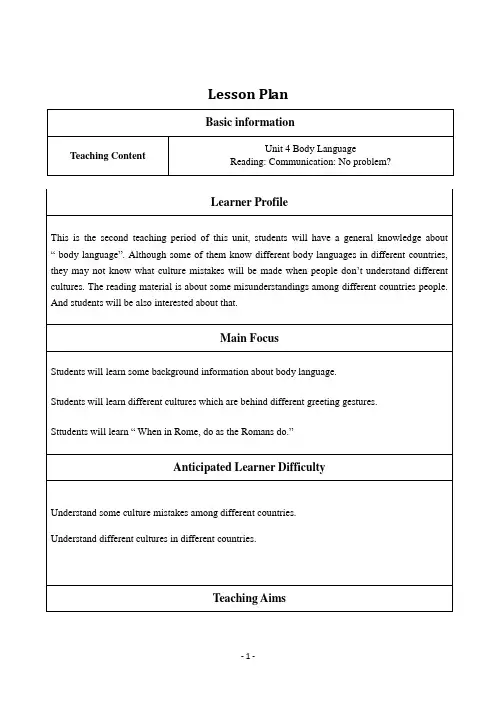
Part 3 Review
and homework
Akira Nagata – George Cook Ahmed Aziz – men/women Darlene Coulon – Tony Garcia
Study and respect different cultures
2. Role play the situation
For example: Tony Garcia from Colombia wants to material and find
touch Julia’s shoulder and kiss her cheek.
different cultural mistakes.
Q: Why Darlene Coulon kissed Tony Garcia?
-5-
-4-
Summarize the whole lesson
7'
Homework 1. Recite Para.5 2. Preview the passage Showing Our Feelings.
Blackboard Design
Unit 4 Body Language
Culture mistakes Study and respect When in Rome, do as Romans do
Time 3'
For example: People from Japan bow to others to greet them; People from Britain shake hands with others to greet them.
To arouse students’ intersts and introduce information of body language.
人教高中英语必修4Unit4reading(共23张PPT)
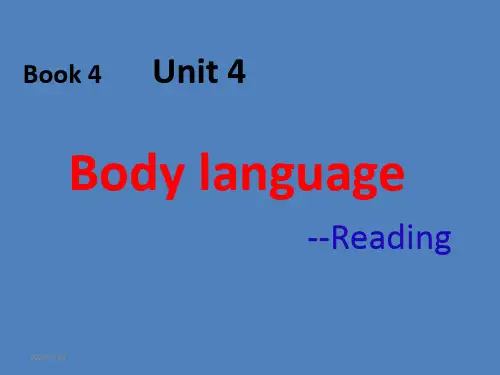
Match the following main ideas with each
Ppaartrt1. (Para.1)
Different people have different body language.
Part 2. (Para. 2~3)
Summary of body language.
2020/7/16
Summary :
Body language is different from culture to culture. We should try to understand and respect each other’s culture in order to make good communication.
2020/7/16
Reading
Communication: No problem?
2020/7/16
Skimming
2020/7/16
Get the main idea of the whole passage
2020/7/16
Different countries have different cultures and body languages , so when people greet each other, they will have different body languages.
2020/7/16
2. From Paragraph 2 we know that Japanese prefer to ___when they are introduced to others . A. bow B. shake hands C. kiss D. touch others’ shoulders
boo4 unit4教案
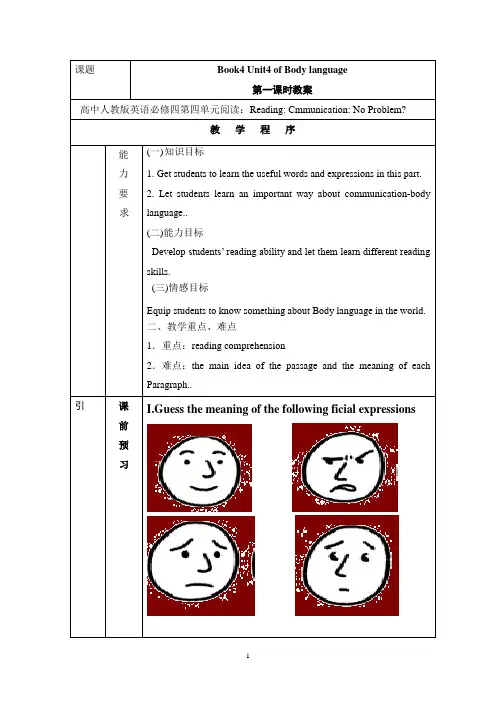
我从来没有看过这么好的电影。
_______________________________________________.
练
课
外
拓
展
possible, probable, likely
1) possible常用于下列结构:
课题
Book4 Unit4 of Body language
第一课时教案
高中人教版英语必修四第四单元阅读:Reading: Cmmunication: No Problem?
教学程序
能
力
要
求
(一)知识目标
1. Get students to learn the usefulwords and expressions in this part.
Find out the main idea of each part
Part1 ( ) ________________________________________
Part2 ( ) _________________________________________
Part3 ( ) __________________________________________
III.Discussion:
What’s the purpose of language?
IV. What is body language?
•Body Language is a form of non-verbal communication.
•It uses movements or positions of our body to show other people what we are thinking or feeling.
人教高中英语必修4unit4reading(共36张ppt)
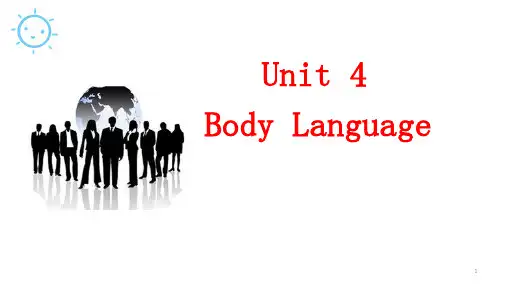
1
communication?( D )
A. optimistic and disapproving B. interested but suspicious C. dissatisfied and objective D. open-minded and tolerant
Positive.
28
Role play
2.What is body language ?
3.What are the different ways of greeting all around the world ?
3
It means …?
I love you !
Nice to meet you! Happy! Well-done!
4
Who and What
Country Name Gender Ways of greeting
Columbia Tony Garcia Britain Julia Smith
Japan Canada Jordan
Akira Nagata George Cook Ahmed Aziz
France China
Physical Distance
close
more certain a little quite close or far a little a little 14
Observe words indicating embrassment caused by different cultural customs
Exposition is a detailed explanation of a topic by giving
instruction, illustration, description, conparision and
人教版英语必修四unit 4(reading:munication:no problem)教案
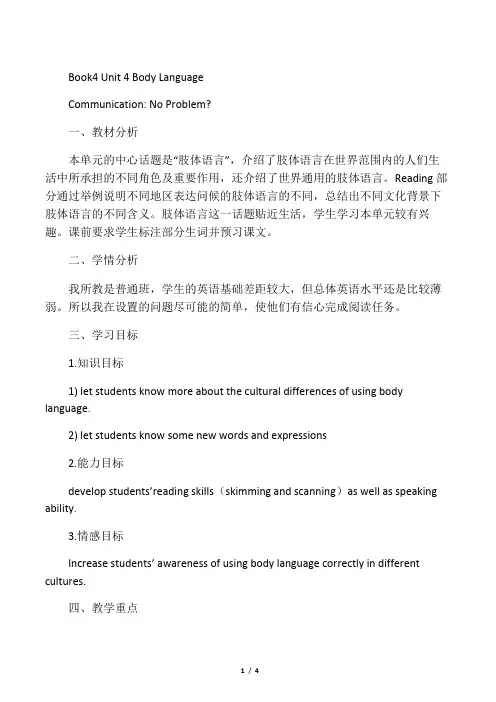
Book4 Unit 4 Body LanguageCommunication: No Problem?一、教材分析本单元的中心话题是“肢体语言”,介绍了肢体语言在世界范围内的人们生活中所承担的不同角色及重要作用,还介绍了世界通用的肢体语言。
Reading部分通过举例说明不同地区表达问候的肢体语言的不同,总结出不同文化背景下肢体语言的不同含义。
肢体语言这一话题贴近生活,学生学习本单元较有兴趣。
课前要求学生标注部分生词并预习课文。
二、学情分析我所教是普通班,学生的英语基础差距较大,但总体英语水平还是比较薄弱。
所以我在设置的问题尽可能的简单,使他们有信心完成阅读任务。
三、学习目标1.知识目标1) let students know more about the cultural differences of using body language.2) let students know some new words and expressions2.能力目标develop students’reading skills(skimming and scanning)as well as speaking ability.3.情感目标Increase students’ awareness of using body language correctly in different cultures.四、教学重点let students master the differences and similarity of body language in different parts of the world.五、教学难点1. develop students’ reading ability2. ask the students to show their opinions in English.六、教学方法1. task-based teaching and learning2. discussion七、教学过程Step 1warming up1.首先由“waysofcommunicating”引出“bodylanguage”,包括facialexpression,gesture,action.接着通过一些图片来表现不同的肢体语言。
人教高中英语必修4Unit4Reading (共36张PPT)
1. BNoodnyeloafntghueasgeeaicntisoonms eisceoiuthnetrigeosoisd ogroobdad.
while some in others is bad. N2o.t aAllll members of a culture behave in the same
way. 3. Studying international customs can
certainly help avoid difficulties in today’s world of cultural crossroads.
What is the main idea of the text? A. There are different customs in different
Fill in the blanks: The first person t_o__a_r_ri_v(earrive) was Tony
Garcia from Columbia,c_l_o_s_e_ly(close) followed by
Julia Smith from Britain. When thweeyr_e_i_n_t_r_o_d_u_c_e_d (introduce) to each other, Tony approached Julia, touched her shoulder and kissed her on the cheek . Julia stepped backa_p_p_e__a_ri_n_g(appear)surprised. Akira Nagata from Japan came in smiling at the same time with George Cook from Canada. As they
人教高中英语必修4Unit4ReadingPPT课堂课件(19页)
messages and different body movements have different meanings. D. The importance of knowing customs.
人教高中英语必修4Unit4ReadingPPT 课堂课 件(19页 )( -精精品品P)PT课 件
end
人教高中英语必修4Unit4ReadingPPT 课堂课 件(19页 )( -精精品品P)PT课 件
Try: pair work
人教高中英语必修4Unit4ReadingPPT 课堂课 件(19页 )( -精精品品P)PT课 件
人教高中英语必修4Unit4ReadingPPT 课堂课 件(19页 )( -精精品品P)PT课 件
Intensive reading
Part One:
1. Why are the people visiting China?
You are sent to Pudong Airport to mBeeectaubsuestinheeyssarpeeinotperlees. ted in the
人教高中英语必修4Unit4ReadingPPT 课堂课 件(19页 )( -精精品品P)PT课 件
人教高中英语必修4Unit4ReadingPPT 课堂课 件(19页 )( -精精品品P)PT课 件
Class Is Over!
人教高中英语必修4Unit4ReadingPPT 课堂课 件(19页 )( -精精品品P)PT课 件
Madame Coulon
人教高中英语必修4Unit4reading(共20张PPT)
1
2
Tony
Julia
Akira
George
Aziz
writer
3
Tony
Coulon
4
Greeting 1
Tony Julia
approached touched kissed
stepped surprised hands in defence
Columbia & Britain misunderstanding
Summary
Columbia & Britain Japan & Canada Jordan & China
France & Colombia
Body languages differ from country
to country.
"Some body languages are good, while some are bad."
?
ቤተ መጻሕፍቲ ባይዱ
When in Rome, do as Romans do.
A. Write a short passage about your understanding of Body Language.
B. Do more detailed reading after class.
1、只要有坚强的意志力,就自然而然地会有能耐、机灵和知识。2、你们应该培养对自己,对自己的力量的信心,百这种信心是靠克服障碍,培养意志和锻炼意志而获得的。 3、坚强的信念能赢得强者的心,并使他们变得更坚强。4、天行健,君子以自强不息。5、有百折不挠的信念的所支持的人的意志,比那些似乎是无敌的物质力量有更强大 的威力。6、永远没有人力可以击退一个坚决强毅的希望。7、意大利有一句谚语:对一个歌手的要求,首先是嗓子、嗓子和嗓子……我现在按照这一公式拙劣地摹仿为:对 一个要成为不负于高尔基所声称的那种“人”的要求,首先是意志、意志和意志。8、执着追求并从中得到最大快乐的人,才是成功者。9、三军可夺帅也,匹夫不可夺志也。 10、发现者,尤其是一个初出茅庐的年轻发现者,需要勇气才能无视他人的冷漠和怀疑,才能坚持自己发现的意志,并把研究继续下去。11、我的本质不是我的意志的结果, 相反,我的意志是我的本质的结果,因为我先有存在,后有意志,存在可以没有意志,但是没有存在就没有意志。12、公共的利益,人类的福利,可以使可憎的工作变为可 贵,只有开明人士才能知道克服困难所需要的热忱。13、立志用功如种树然,方其根芽,犹未有干;及其有干,尚未有枝;枝而后叶,叶而后花。14、意志的出现不是对愿 望的否定,而是把愿望合并和提升到一个更高的意识水平上。15、无论是美女的歌声,还是鬓狗的狂吠,无论是鳄鱼的眼泪,还是恶狼的嚎叫,都不会使我动摇。16、即使 遇到了不幸的灾难,已经开始了的事情决不放弃。17、最可怕的敌人,就是没有坚强的信念。18、既然我已经踏上这条道路,那么,任何东西都不应妨碍我沿着这条路走下 去。19、意志若是屈从,不论程度如何,它都帮助了暴力。20、有了坚定的意志,就等于给双脚添了一对翅膀。21、意志坚强,就会战胜恶运。22、只有刚强的人,才有神 圣的意志,凡是战斗的人,才能取得胜利。23、卓越的人的一大优点是:在不利和艰难的遭遇里百折不挠。24、疼痛的强度,同自然赋于人类的意志和刚度成正比。25、能 够岿然不动,坚持正见,度过难关的人是不多的。26、钢是在烈火和急剧冷却里锻炼出来的,所以才能坚硬和什么也不怕。我们的一代也是这样的在斗争中和可怕的考验中 锻炼出来的,学习了不在生活面前屈服。27、只要持续地努力,不懈地奋斗,就没有征服不了的东西。28、立志不坚,终不济事。29、功崇惟志,业广惟勤。30、一个崇高 的目标,只要不渝地追求,就会居为壮举;在它纯洁的目光里,一切美德必将胜利。31、书不记,熟读可记;义不精,细思可精;惟有志不立,直是无着力处。32、您得相 信,有志者事竟成。古人告诫说:“天国是努力进入的”。只有当勉为其难地一步步向它走去的时候,才必须勉为其难地一步步走下去,才必须勉为其难地去达到它。33、 告诉你使我达到目标的奥秘吧,我唯一的力量就是我的坚持精神。34、成大事不在于力量的大小,而在于能坚持多久。35、一个人所能做的就是做出好榜样,要有勇气在风 言风语的社会中坚定地高举伦理的信念。36、即使在把眼睛盯着大地的时候,那超群的目光仍然保持着凝视太阳的能力。37、你既然期望辉煌伟大的一生,那么就应该从今 天起,以毫不动摇的决心和坚定不移的信念,凭自己的智慧和毅力,去创造你和人类的快乐。38、一个有决心的人,将会找到他的道路。39、在希望与失望的决斗中,如果 你用勇气与坚决的双手紧握着,胜利必属于希望。40、富贵不能淫,贫贱不能移,威武不能屈。41、生活的道路一旦选定,就要勇敢地走到底,决不回头。42、生命里最重 要的事情是要有个远大的目标,并借助才能与坚持来完成它。43、事业常成于坚忍,毁于急躁。我在沙漠中曾亲眼看见,匆忙的旅人落在从容的后边;疾驰的骏马落在后头, 缓步的骆驼继续向前。44、有志者事竟成。45、穷且益坚,不坠青云之志。46、意志目标不在自然中存在,而在生命中蕴藏。47、坚持意志伟大的事业需要始终不渝的精神。 48、思想的形成,首先是意志的形成。49、谁有历经千辛万苦的意志,谁就能达到任何目的。50、不作什么决定的意志不是现实的意志;无性格的人从来不做出决定。我终 生的等待,换不来你刹那的凝眸。最美的不是下雨天,是曾与你躲过雨的屋檐。征服畏惧、建立自信的最快最确实的方法,就是去做你害怕的事,直到你获得成功的经验。 真正的爱,应该超越生命的长度、心灵的宽度、灵魂的深度。生活真象这杯浓酒,不经三番五次的提炼呵,就不会这样可口!人格的完善是本,财富的确立是末能力可以慢 慢锻炼,经验可以慢慢积累,热情不可以没有。不管什么东西,总是觉得,别人的比自己的好!只有经历过地狱般的折磨,才有征服天堂的力量。只有流过血的手指才能弹 出世间的绝唱。对时间的价值没有没有深切认识的人,决不会坚韧勤勉。第一个青春是上帝给的;第二个的青春是靠自己努力的。不要因为寂寞而恋爱,孤独是为了幸福而 等待。每天清晨,当我睁开眼睛,我告诉自己:我今天快乐或是不快乐,并非由我所遭遇的事情造成的,而应该取决于我自己。我可以自己选择事情的发展方向。昨日已逝,
人教必修四unit 4 reading
However, people from places like Spain, Italy or South American countries approach others closely and are more likely to touch them. Most people around the world now greet each other by shaking hands, but some cultures use other greetings as well, such as the Japanese, who prefer to bow.
- 1、下载文档前请自行甄别文档内容的完整性,平台不提供额外的编辑、内容补充、找答案等附加服务。
- 2、"仅部分预览"的文档,不可在线预览部分如存在完整性等问题,可反馈申请退款(可完整预览的文档不适用该条件!)。
- 3、如文档侵犯您的权益,请联系客服反馈,我们会尽快为您处理(人工客服工作时间:9:00-18:30)。
Book4 Unit 4 Body Language
Communication: No Problem?
一、教材分析
本单元的中心话题是“肢体语言”,介绍了肢体语言在世界范围内的人们生活中所承担的例外角色及严重作用,还介绍了世界通用的肢体语言。
Reading部分通过举例说明例外地区表达问候的肢体语言的例外,总结出例外文化背景下肢体语言的例外含义。
肢体语言这一话题贴近生活,学生学习本单元较有兴趣。
课前要求学生标注部分生词并预习课文。
二、学情分析
我所教是普通班,学生的英语基础差距较大,但总体英语水平还是比较单薄。
所以我在设置的问题尽可能的简单,使他们有信心完成阅读任务。
三、学习目标
1.知识目标
1) let students know more about the cultural differences of using body language.
2) let students know some new words and expressions
2.能力目标
develop students’reading skills(skimming and scanning)as well as speaking ability.
3.情感目标
Increase students’ awareness of using body language correctly in different cultures.
四、教学重点
let students master the differences and similarity of body language in different parts of the world.
五、教学难点
1. develop students’ reading ability
2. ask the students to show their opinions in English.
六、教学方法
1. task-based teaching and learning
2. discussion
七、教学过程
Step 1warming up
1.首先由“waysofcommunicating”引出“bodylanguage”,包括facialexpression,gesture,action.接着通过一些图片来表现例外的肢体语言。
这个环节主要是为了引起学生的阅读兴趣。
2.让学生观察课本P25的四幅图片并表述其肢体语言所传达的含义。
Step 2pre-reading
1.通过提问“H ow many ways can you think of to greet someone if you cannot speak?”引出本篇文章的主题。
向学生展示一些图片,以便学生更清撤地了解例外地区表示问候的肢体语言。
2.Predicting.让学生借助文章的题目和图片,预测文章的主题和主要内容,对文章有初步的了解。
Step 3 Reading
1.Answer two questions.
How many international students are there in the story?
Who are they and where are they come from?
2.skimming
在这个环节中,要求学生快速阅读,找出文章和每段的大意,有助于学生更好地把握全文。
Readthepassageanddividethewholepassageintoseveralpartsandmatchthemain idea.
Part 1(Para. 1)People from different countries express greetings in different ways.Part 2(Para. 2-3)Meet the visitors at the airport.
Part 3(Para. 4)Summary of body language.
Part 4(Para. 5)Different peoples have different body languages.
Try to finish the main idea of the text.
The text is mainly about different ______________ in different countries. In order to avoiddifficulties in today’s world of cultural crossroads, we
should________________________.
3.scanning
Read the passage quickly and finish jinban P43 task2.
4.careful reading
How do different international students behave when they greet people? Completethe chart with information from the passage. P27
Name
Tony Garcia
NameDescription
man from Japan
DescriptionBody Language
no touching
Body LanguageToWhomeveryone
ToWhomto men
to womenGeorgeCook
shakehandsandkisstwice
on each cheek
Read the text carefully, and do the T or F. If false, correct the mistakes.
1. English men often stand close to others or touch strangers as soon as they meet.()
2. Most people around the world now greet each other by kissing. ()
3. Japanese will bow to others as greeting. ()
5.post reading
Answer the following questions.
Is the author of this passage male or female? How do you know?
“WheninRome,doastheRomansdo.”Whatdoyouthinkthisfamoussayingmeans?
Step 5 Homework
1.Finish the exercise
2.line out some difficult sentences and useful language points.
3.。
